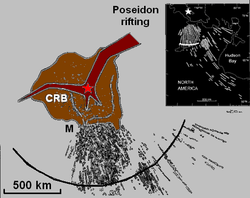Mackenzie hotspot

Tectonic and magmatic features associated with the Mackenzie Large Igneous Province, including the rifting that created the Poseidon Ocean. Red star shows the initial Mackenzie plume zone relative to the lithosphere.
The Mackenzie hotspot was a volcanic hotspot that existed about 1,267 million years ago across Canada from the Northwest Territories and Nunavut.
Extent
The Mackenzie hotspot is responsible for the creation of the Mackenzie Large Igneous Province, which contains the largest dike swarm on Earth.[1] During its formation, eruption of plateau lavas near the Coppermine River, built an extensive volcanic plateau about 1,200 million years ago with an area of about 170,000 km2 (66,000 sq mi) representing a volume of lavas of at least 500,000 km3 (120,000 cu mi).
The Mackenzie hotspot also resulted in the opening of the Mesoproterozoic Poseidon Ocean.
See also
References
- ↑ Pilkington and Roest. "Removing varying directional trends in aeromagnetic data." Geophysics vol. 63 no. 2 (1998), pp. 446–453.
This article is issued from Wikipedia - version of the 2/4/2015. The text is available under the Creative Commons Attribution/Share Alike but additional terms may apply for the media files.